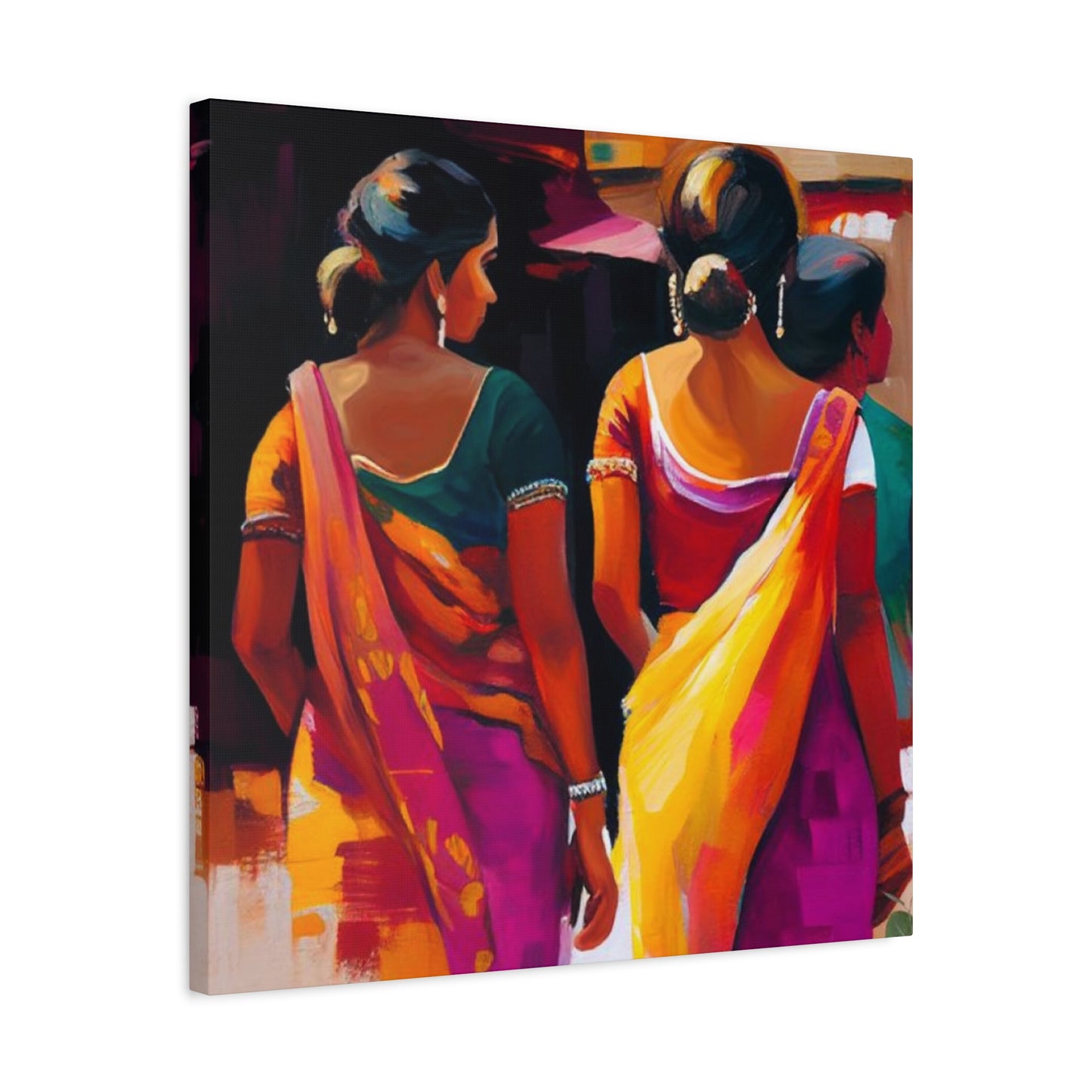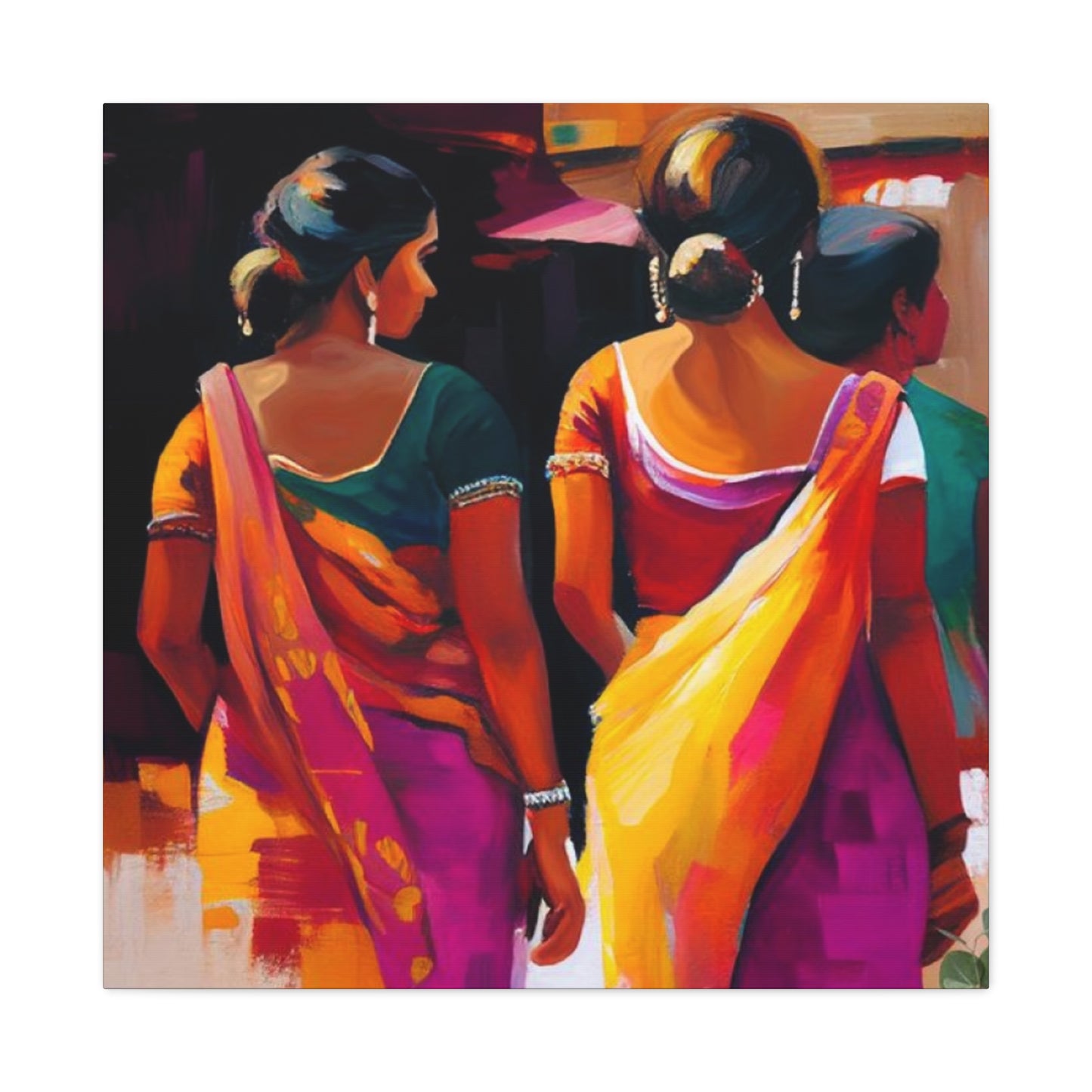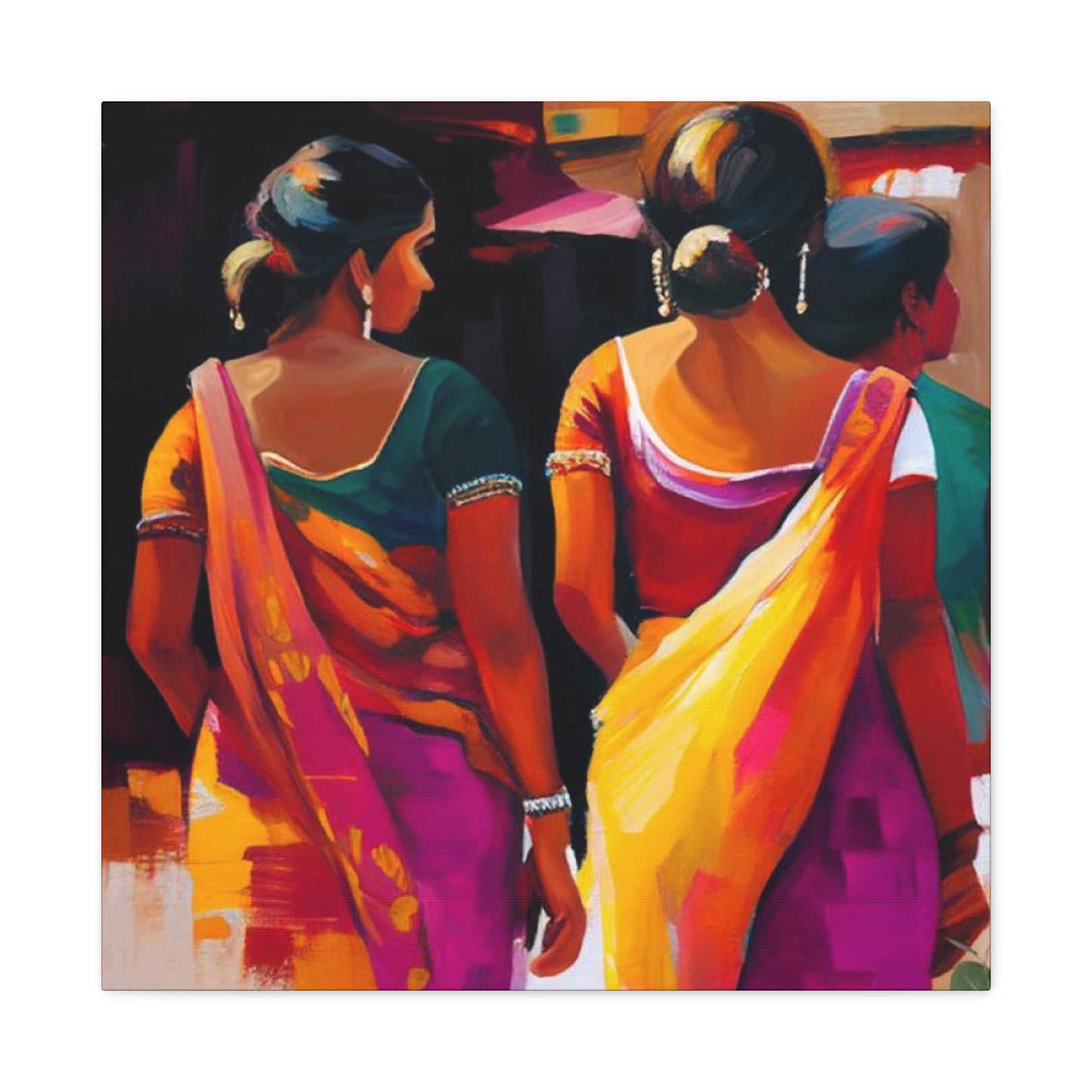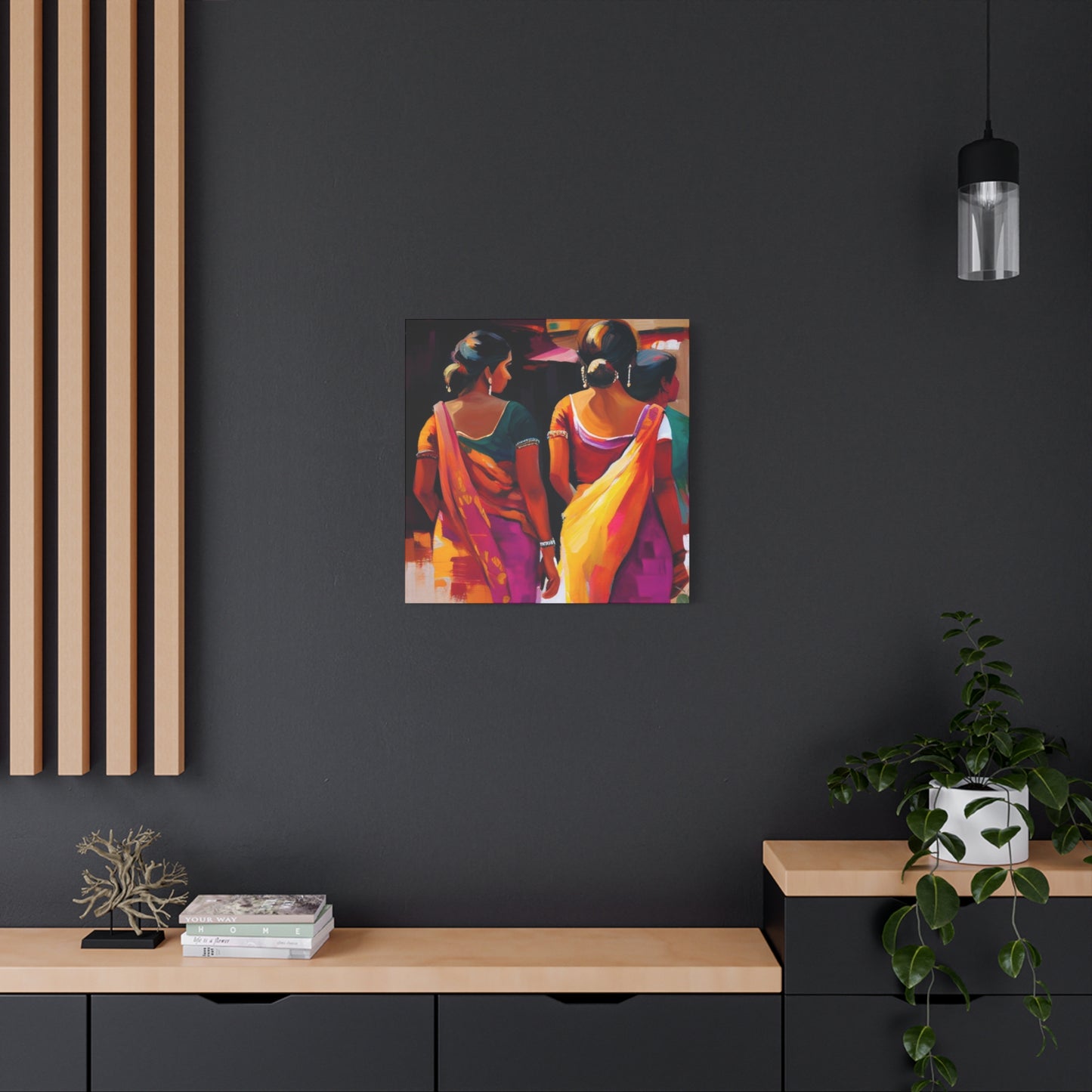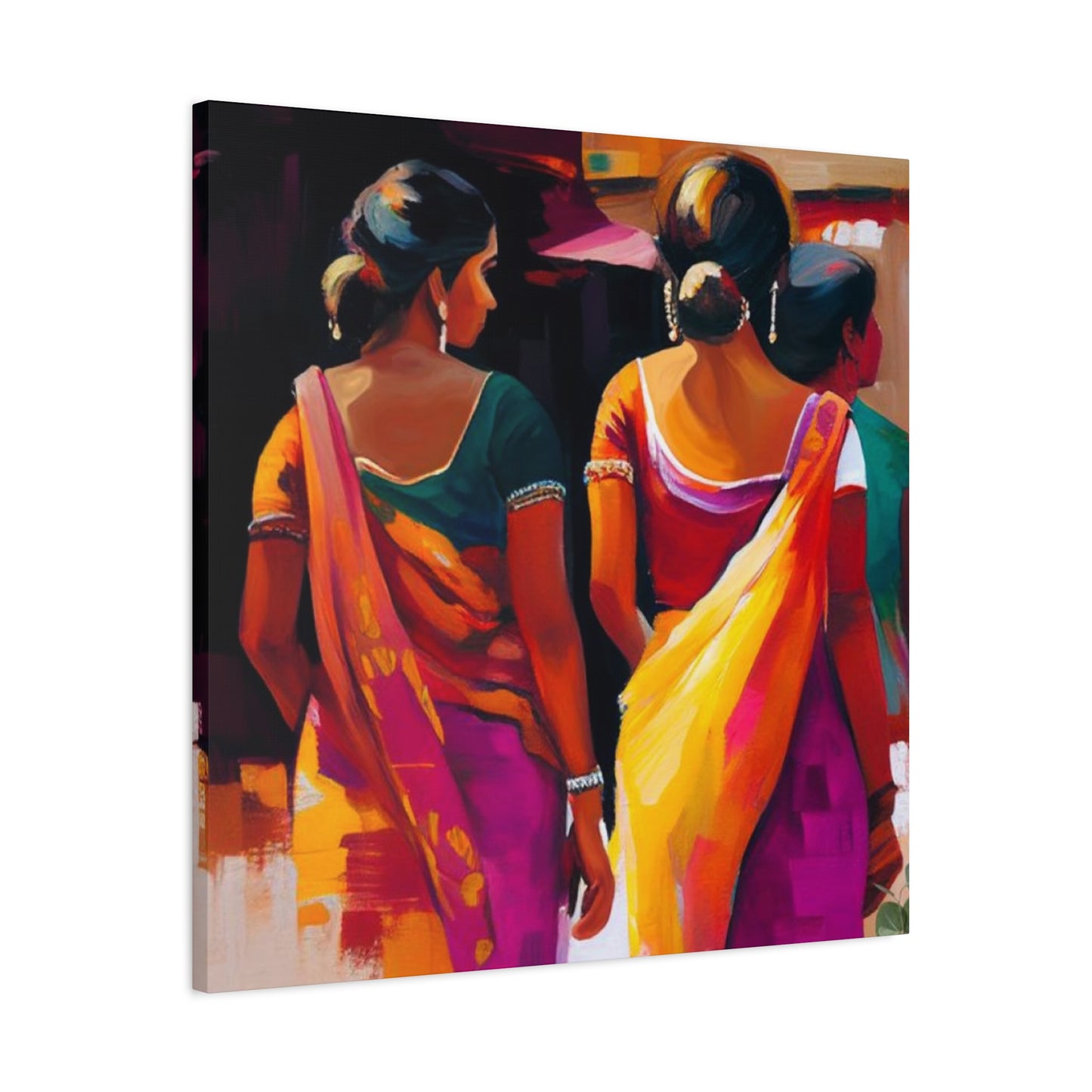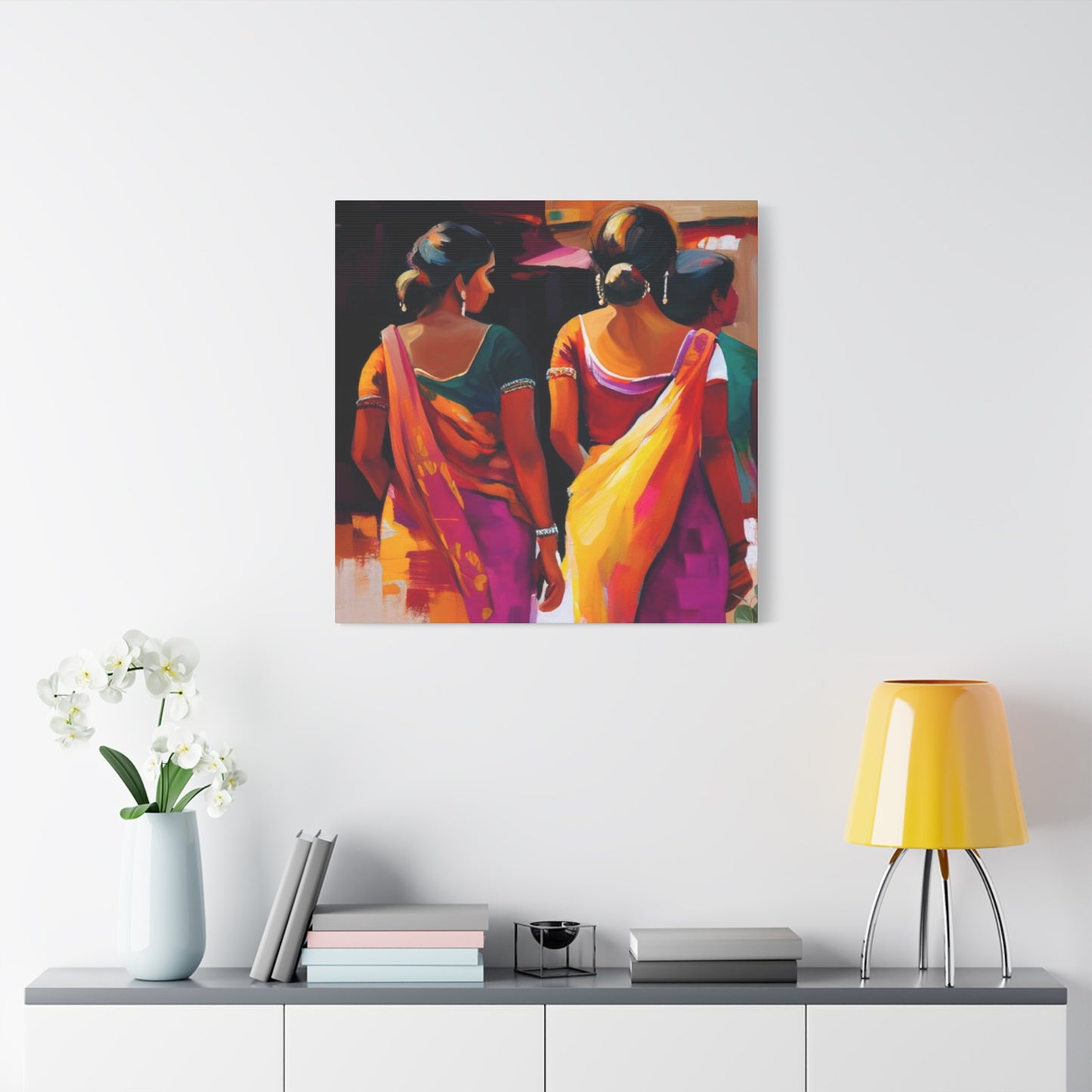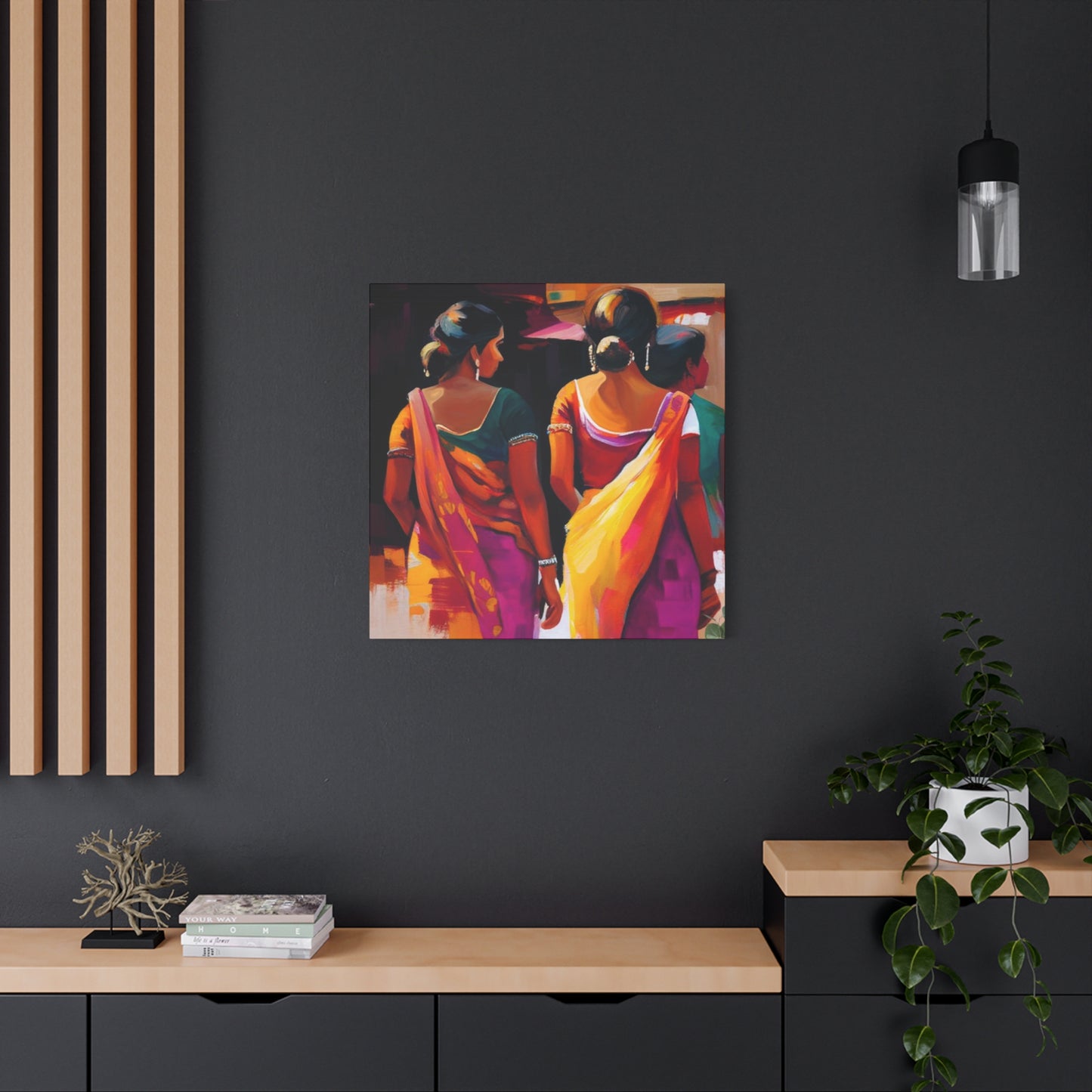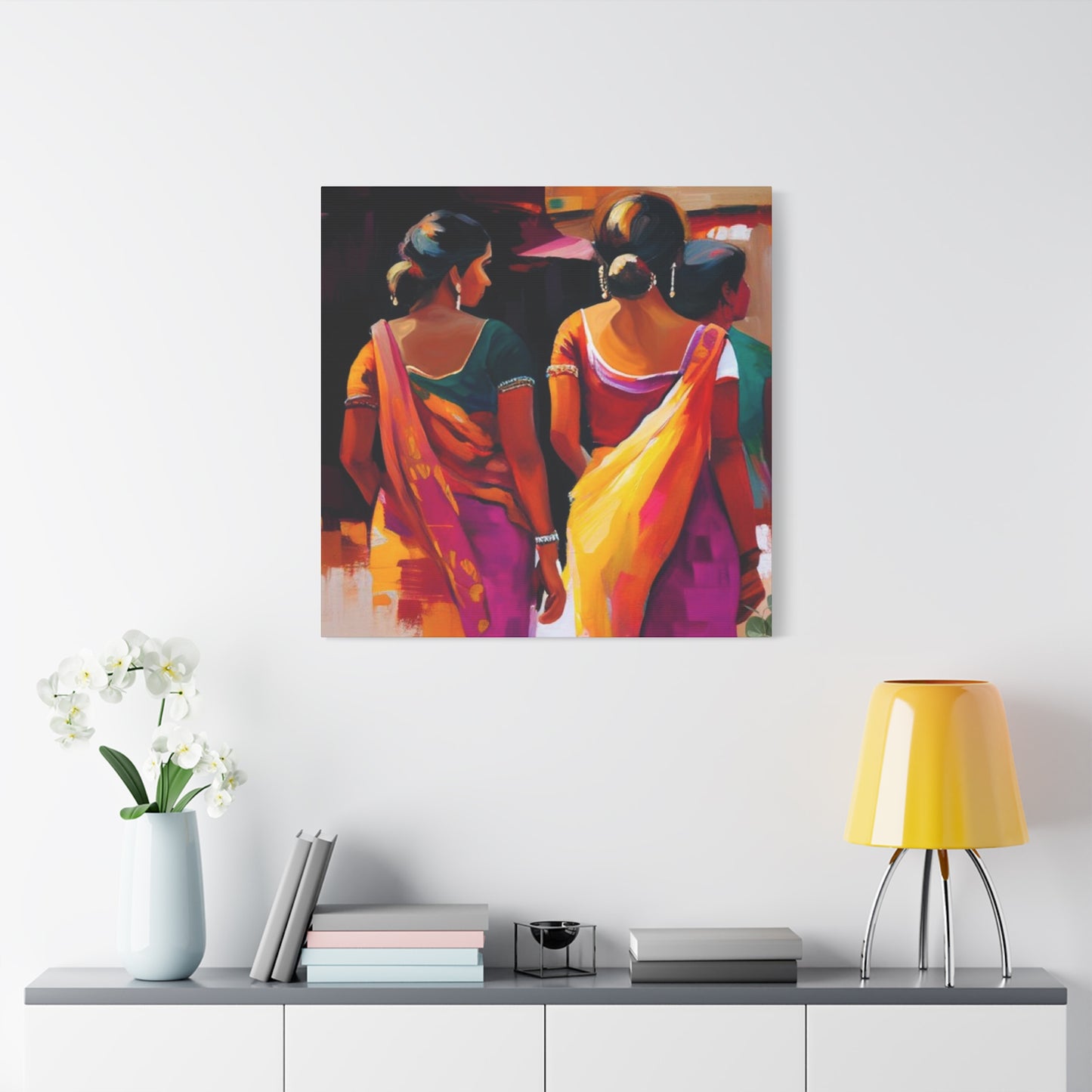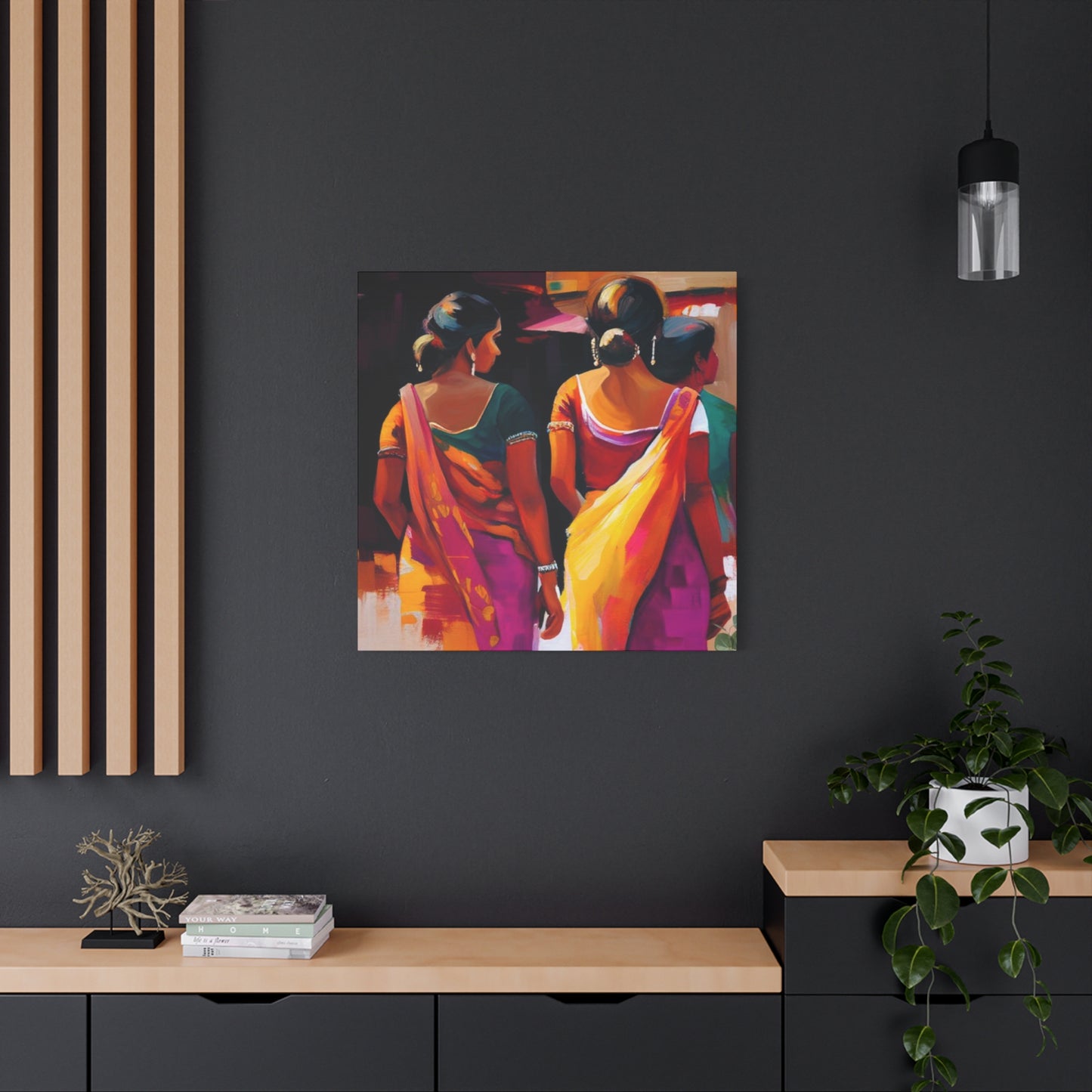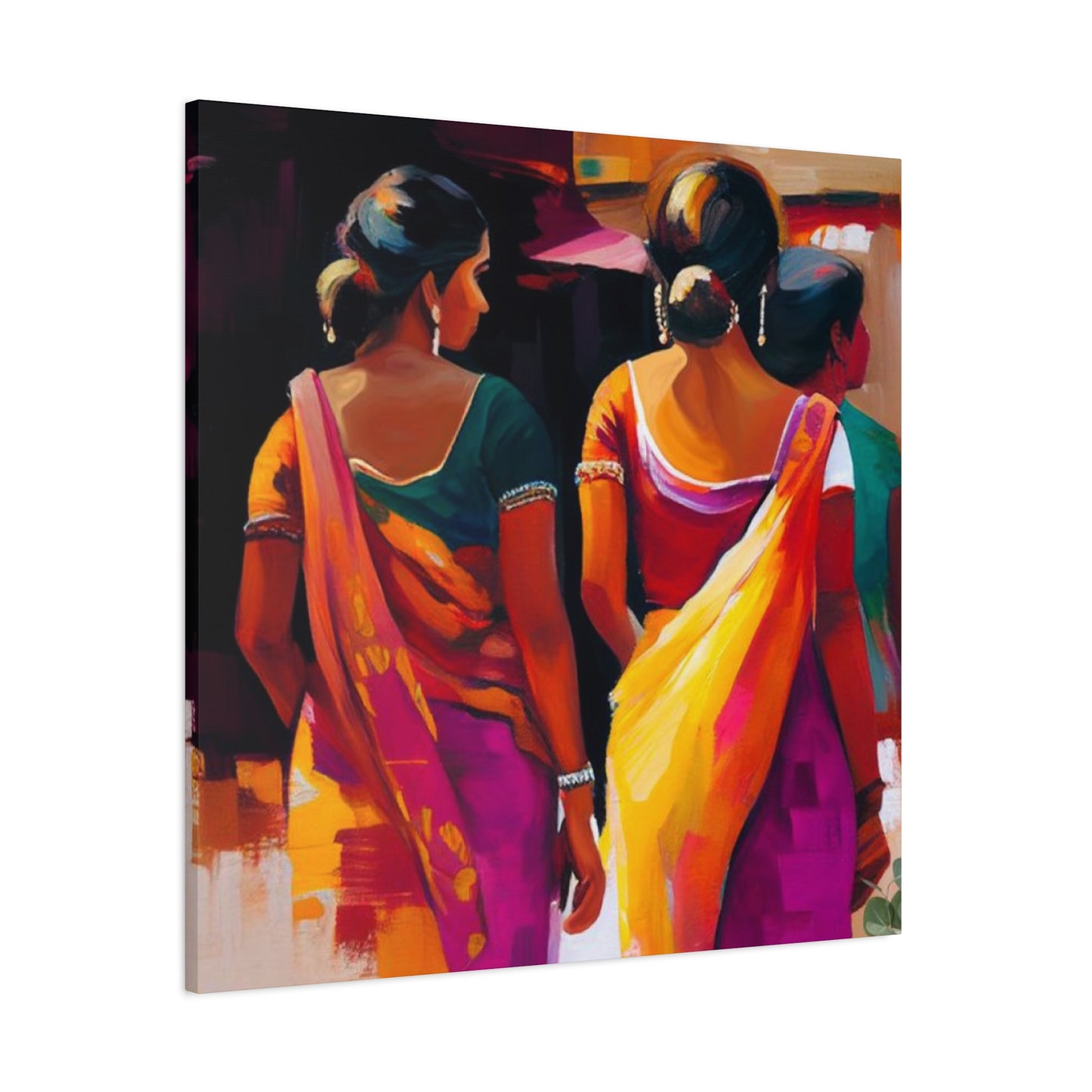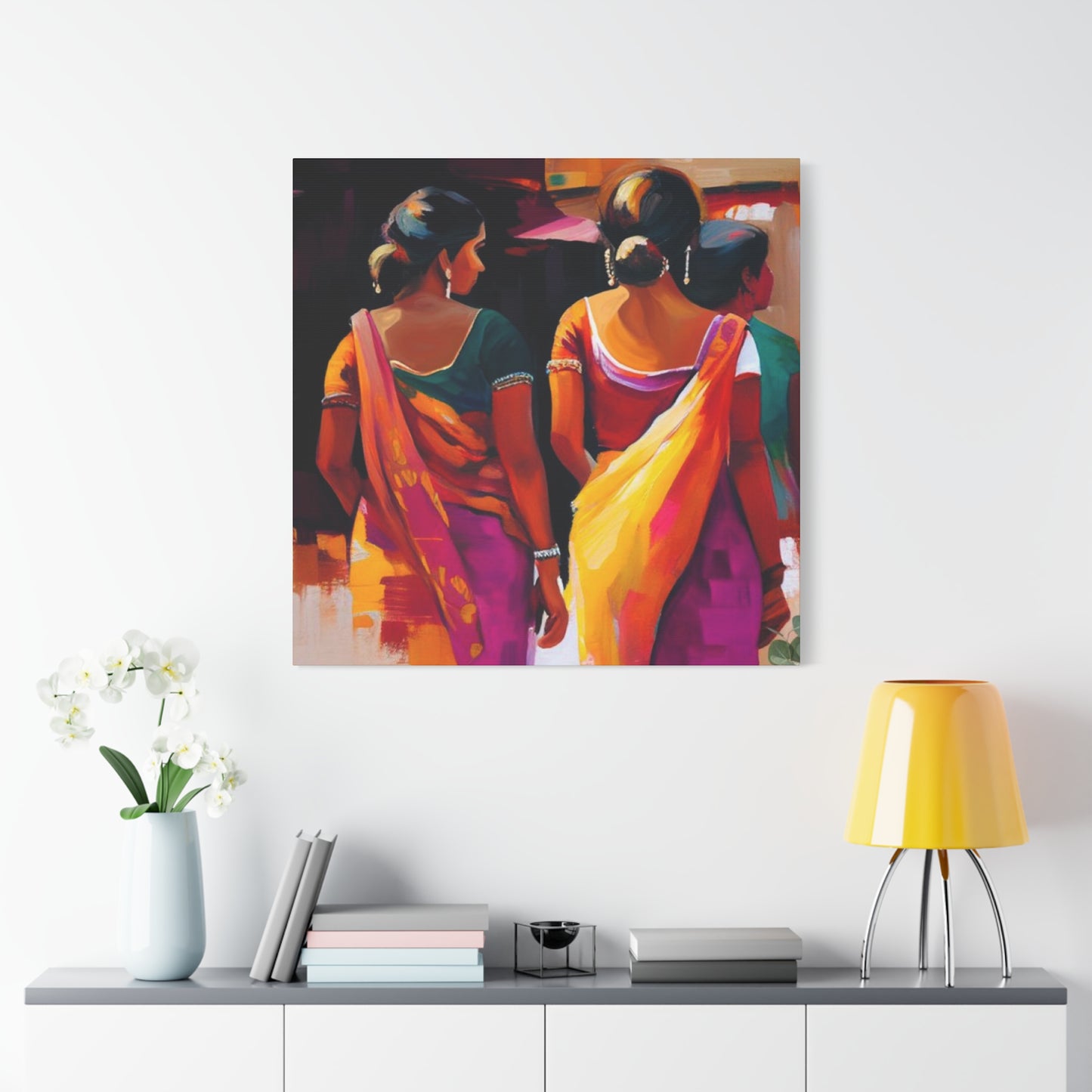Artistic Femininity: A Journey Through the World of indian Women Aesthetic Wall art Décor
The artistic representation of women in Indian culture has been a cornerstone of visual storytelling for thousands of years. From ancient temple frescoes to contemporary gallery pieces, the depiction of feminine grace, strength, and spirituality continues to captivate audiences worldwide. Wall art featuring Indian women reflects the diverse cultural tapestry of the subcontinent, celebrating regional traditions, religious mythology, and everyday life through various artistic mediums. These visual narratives not only serve as decorative elements but also as cultural ambassadors that communicate the rich heritage and aesthetic sensibilities developed over millennia.
The contemporary appreciation for traditional Indian women's portraiture in wall art has experienced remarkable growth as global audiences seek authentic cultural expressions in their living spaces. This artistic genre encompasses everything from classical paintings depicting goddesses and queens to modern interpretations of village women going about their daily routines. Each piece carries within it layers of meaning, symbolism, and cultural significance that transform ordinary walls into windows opening onto the vibrant world of Indian traditions and values.
Historical Evolution of Women's Portrayal in Indian Visual Arts
The journey of depicting women in Indian art spans several thousand years, beginning with the prehistoric cave paintings of Bhimbetka that date back to approximately 30,000 BCE. These early representations showed women participating in daily activities, hunting, and communal gatherings, establishing a tradition of capturing feminine presence in visual narratives. As civilizations developed along the Indus Valley, terracotta figurines and seals began featuring female forms, often associated with fertility and abundance, creating the foundation for the spiritual and material significance attached to women's imagery.
During the Mauryan and Gupta periods, the artistic representation of women reached new heights of sophistication. The Ajanta and Ellora cave paintings showcased women in elaborate court scenes, as celestial beings, and in various stages of spiritual enlightenment. These frescoes demonstrated advanced techniques in shading, perspective, and emotional expression that influenced artistic traditions for centuries. The feminine figures in these works displayed the ideals of beauty prevalent during those eras while also conveying narratives from Buddhist and Hindu texts.
Medieval Indian art saw the proliferation of miniature paintings, particularly under the patronage of Rajput and Mughal courts. These exquisite works often centered on women as the primary subjects, whether as royal consorts, mythological heroines, or poetic muses. The Rajput paintings emphasized the connection between women and nature, frequently depicting them in garden settings or as embodiments of different seasons and moods. Mughal miniatures brought Persian influences, creating a unique synthesis that portrayed women with refined elegance and attention to costume details.
The colonial period introduced new artistic perspectives and techniques, blending European academic styles with traditional Indian subjects. Artists like Raja Ravi Varma revolutionized Indian art by creating oleographs that made high-quality reproductions of paintings featuring Indian women accessible to the masses. His works depicted Hindu goddesses and scenes from epics with a realistic approach that merged Western painting techniques with Indian themes, creating images that became iconic representations of Indian womanhood.
Post-independence India witnessed an explosion of artistic experimentation as artists sought to define national identity while exploring individual expression. Women in art became symbols of the nation itself, representing resilience, tradition, and progress simultaneously. Contemporary artists like M.F. Husain, Jamini Roy, and countless others created distinctive styles that reimagined the feminine form through modernist, folk, and abstract lenses, ensuring that the tradition of depicting women remained vibrant and evolving.
Regional Artistic Traditions and Their Unique Feminine Representations
India's vast geographical and cultural diversity has given rise to numerous regional art forms, each with its distinctive approach to portraying women. The Madhubani paintings of Bihar feature women as central figures in geometric and floral patterns, depicting scenes from daily life, festivals, and mythological stories. These paintings, traditionally created by women on the walls of their homes, use natural dyes and pigments to create vibrant compositions that celebrate femininity through stylized forms and symbolic imagery.
Warli art from Maharashtra presents a tribal perspective on women's roles in community life. Using simple geometric shapes, Warli paintings show women engaged in agricultural activities, dancing in ceremonies, and nurturing families. The minimalist aesthetic of Warli art conveys profound narratives about the interconnectedness of women with nature and community, emphasizing their essential role in maintaining social harmony and continuity.
Kalamkari art from Andhra Pradesh and Telangana showcases women in intricate narrative compositions, often depicting scenes from Hindu epics. The hand-painted or block-printed textiles feature women as goddesses, queens, and ordinary villagers, all rendered with meticulous attention to detail in clothing, jewelry, and posture. The organic vegetable dyes used in Kalamkari create earthy tones that enhance the traditional appeal of these representations.
Pattachitra paintings from Odisha and West Bengal present women with elongated features and elaborate ornamentation, particularly in depictions of Hindu deities and mythological scenes. The bold lines and vibrant colors characteristic of Pattachitra create visually striking representations that emphasize the divine and heroic aspects of femininity. These paintings often feature women in dynamic poses, conveying action and emotion through stylized gestures.
The Tanjore paintings of Tamil Nadu represent women, especially goddesses, with remarkable opulence through the use of gold foils and precious stones. These embossed artworks create three-dimensional effects that highlight the regal and divine status of their female subjects. The rich colors and luxurious materials used in Tanjore paintings reflect the South Indian aesthetic sensibility that associates feminine divinity with material abundance and visual splendor.
Symbolism and Cultural Significance in Women's Imagery
The representation of women in Indian wall art carries deep symbolic meanings that extend far beyond aesthetic considerations. Women are frequently portrayed as embodiments of Shakti, the divine feminine energy that powers creation and sustains the universe. This concept infuses their artistic representation with spiritual significance, transforming even simple depictions of women into meditations on cosmic power and creative force.
The association of women with nature appears consistently across different art forms and regions. Women are depicted alongside lotuses representing purity, peacocks symbolizing beauty and pride, and trees signifying fertility and life-giving properties. These natural elements create a visual language that communicates the perceived harmony between feminine essence and natural cycles, reinforcing cultural beliefs about women's roles as nurturers and life-bearers.
Jewelry and clothing in women's portraiture serve as markers of regional identity, social status, and marital position. The specific ornaments adorning painted women convey information about their geographical origin, with each region having distinctive jewelry styles. Married women are typically shown wearing particular symbols like sindoor, mangalsutra, or bangles, making these artistic representations valuable documents of cultural practices and social norms.
Colors used in depicting women carry symbolic weight within Indian artistic traditions. Red signifies auspiciousness and fertility, frequently appearing in bridal imagery and representations of married women. Yellow indicates sanctity and devotion, often used for religious women or those engaged in worship. White can represent purity or widowhood depending on context, while green symbolizes new beginnings and prosperity. Understanding this color symbolism adds layers of meaning to seemingly simple compositions.
Postures and gestures in women's portrayal follow codified systems like mudras from classical dance traditions. A woman shown with hands in a specific position conveys particular emotions or intentions, from blessing and protection to invitation and devotion. These gestural elements connect wall art to broader performance traditions, creating visual narratives that viewers familiar with cultural codes can read like text.
Goddesses and Divine Feminine in Wall Décor
Hindu mythology provides an inexhaustible source of feminine imagery for wall art, with goddesses representing different aspects of divine power and human aspiration. Lakshmi, the goddess of wealth and prosperity, appears seated or standing on a lotus, often with gold coins flowing from her hands. Her imagery in homes and businesses serves both decorative and devotional purposes, inviting abundance and good fortune while adding spiritual significance to living spaces.
Saraswati, the goddess of knowledge and arts, is depicted with a veena, books, and a swan, embodying the Indian reverence for learning and creativity. Wall art featuring Saraswati finds particular favor in educational institutions and homes with students, serving as inspiration and blessing for intellectual pursuits. The serene expression and white garments of Saraswati representations convey the calm focus required for scholarly achievement.
Durga and Kali represent the fierce protective aspects of feminine divinity, shown riding lions or tigers while wielding multiple weapons. These powerful images celebrate the strength and courage of women while providing protection against negative forces. The dynamic composition of Durga slaying the buffalo demon Mahishasura has become one of the most recognizable images in Indian art, reproduced in countless variations across different media.
Parvati, Sita, and Radha represent the devoted wife and lover archetypes, appearing in scenes that emphasize feminine grace, loyalty, and spiritual devotion. These representations often show them alongside their divine consorts, creating compositions that celebrate marital harmony and devotional love. The softness and elegance of these depictions offer a counterpoint to the fierce goddess imagery, presenting the full spectrum of feminine qualities.
Regional goddesses like Meenakshi, Kamakhya, and Vaishno Devi receive artistic representation specific to their local traditions and temple iconography. These localized goddess images connect wall art to pilgrimage traditions and regional spiritual practices, allowing devotees to maintain visual connection with sacred sites. The distinctive features of each regional goddess representation create diverse artistic interpretations of divine femininity.
Contemporary Reinterpretations of Traditional Themes
Modern artists have embraced traditional themes of Indian women while infusing them with contemporary sensibilities and techniques. Digital art and mixed media approaches allow for innovative presentations of classical subjects, blending photographic elements with traditional painting styles to create hybrid works that appeal to younger audiences. These contemporary pieces maintain connections to cultural heritage while speaking to modern aesthetic preferences and living spaces.
Feminist perspectives have influenced recent artistic representations of Indian women, challenging traditional narratives and presenting more complex, empowered portrayals. Artists explore themes of female agency, resistance, and individuality while still working within recognizable cultural frameworks. These works often juxtapose traditional costumes and settings with modern attitudes and expressions, creating visual dialogues between past and present.
Minimalist approaches to Indian women's imagery have gained popularity in contemporary interior design contexts. Simplified line drawings and monochromatic color schemes distill classical poses and costumes into essential elements, creating sophisticated pieces that fit seamlessly into modern décor while maintaining cultural authenticity. These minimal representations demonstrate how traditional subjects can adapt to changing aesthetic preferences without losing their cultural essence.
Street art and public murals featuring Indian women have brought these artistic traditions into urban spaces, making them accessible to wider audiences. Large-scale wall paintings in cities across India and internationally showcase regional women's costumes, festival scenes, and daily life vignettes that celebrate cultural diversity. These public art installations transform shared spaces into galleries that educate and inspire viewers about Indian cultural traditions.
International artists have increasingly incorporated Indian women's imagery into their work, creating cross-cultural artistic dialogues. These interpretations by non-Indian artists offer fresh perspectives on traditional themes while sometimes sparking conversations about cultural appropriation and authentic representation. The global circulation of Indian women's imagery in wall art reflects the worldwide fascination with Indian culture and aesthetics.
Folk Art Traditions and Rural Women's Representation
Village and rural life provide rich subject matter for Indian wall art, with women often featured as the central figures in agricultural and domestic scenes. These representations celebrate the vital contributions of rural women to family and community sustainability, depicting them harvesting crops, fetching water, cooking, and participating in village festivals. The earthy color palettes and naturalistic settings of these works create warm, inviting compositions that honor everyday labor.
Tribal art traditions present women through distinctive aesthetic lenses shaped by indigenous worldviews and spiritual beliefs. The bold, geometric patterns of Gond art from Madhya Pradesh show women integrated into cosmic diagrams and natural cycles, emphasizing their connection to earth and ancestors. Similarly, Bhil art features women in narrative compositions using dots and dashes to create textured, vibrant representations of tribal life and mythology.
Seasonal and agricultural festivals provide popular themes for folk art featuring women. Paintings depicting Teej, Pongal, Bihu, and other regional celebrations show women in festive attire, dancing, singing, and performing rituals. These joyful compositions capture the communal spirit of rural celebrations while showcasing the regional costume variations and cultural practices associated with different festivals.
Women as storytellers and tradition-bearers appear frequently in folk art, shown gathering with children or other women to share tales and wisdom. These representations acknowledge the crucial role women play in cultural transmission, passing down stories, songs, and values through generations. The intimate settings of these scenes create warm, nostalgic atmospheres that resonate with viewers seeking connections to cultural roots.
Market and bazaar scenes featuring women vendors and shoppers capture the commercial aspects of rural and small-town life. These lively compositions show women selling vegetables, pottery, textiles, and other goods, highlighting their economic contributions beyond domestic labor. The colorful displays of merchandise and the social interactions depicted in these scenes create visually rich narratives about community life.
Classical Dance Forms Frozen in Artistic Expression
The graceful postures of classical Indian dance find permanent expression in wall art that captures the beauty and spiritual significance of these performance traditions. Bharatanatyam dancers from Tamil Nadu appear in tribhanga poses, with elaborate hand gestures and expressive facial features that convey specific emotions and narratives. The traditional costume elements like the pleated fan of fabric, temple jewelry, and gajra flowers receive meticulous attention in these artistic representations.
Kathak dancers from North India are depicted in dynamic spinning poses or in moments of subtle expression, their ghungroo ankle bells visible and their flowing skirts captured mid-twirl. The fusion of Hindu and Islamic cultural elements visible in Kathak costume and style creates unique artistic compositions that reflect the syncretic traditions of regions like Uttar Pradesh and Rajasthan.
Odissi dance imagery presents women in the characteristic tribhanga stance with one hip jutting out, arms creating geometric patterns, and faces showing serene devotional expressions. The connection between Odissi and temple sculpture traditions makes these representations particularly sculptural in quality, with strong emphasis on body curves and architectural framing elements reminiscent of temple niches.
Mohiniyattam dancers from Kerala are shown in swaying poses that evoke the gentle movements of palm trees and waves, their white and gold costumes creating elegant contrasts. The soft, feminine aesthetic of Mohiniyattam finds beautiful expression in wall art that emphasizes flowing lines and graceful curves. These representations often include Kerala's lush natural landscapes as backdrops.
Kuchipudi and Manipuri dance forms contribute their distinctive visual vocabularies to the repertoire of dance-inspired wall art. The narrative emphasis in Kuchipudi leads to dramatic compositions showing dancers portraying specific characters from epics, while Manipuri's circular movement patterns and devotional themes create compositions with circular rhythms and spiritual atmospheres.
Textile Patterns and Costume Details in Visual Art
The extraordinary diversity of Indian textiles finds expression in wall art through detailed representations of women's clothing and the patterns adorning them. Sarees from different regions receive artistic attention, with artists carefully depicting the distinctive weaving patterns, borders, and draping styles that identify geographical origins. A Kanjeevaram silk saree appears different from a Banarasi brocade, which differs from a Patola weave, and these distinctions are lovingly rendered in quality artwork.
Embroidery traditions like chikankari, phulkari, and kantha appear in artistic representations of women's clothing, showcasing the needlework skills passed down through generations. The delicate white-on-white embroidery of chikankari from Lucknow contrasts with the vibrant, bold patterns of Punjabi phulkari, while the narrative running stitches of Bengali kantha tell stories through textile. Wall art capturing these embroidery details celebrates the artistry of textile traditions.
Jewelry representations in women's portraiture demonstrate the remarkable diversity of Indian ornamental traditions. From the elaborate temple jewelry of South India to the enamel work of Rajasthan, from the silver tribal ornaments of northeastern regions to the pearl sets of Hyderabad, each tradition receives artistic documentation through detailed rendering in paintings. The glint of gold, the sparkle of gemstones, and the weight of silver ornaments all find expression through artistic technique.
Regional headwear and hair styling add distinctive elements to women's portrayal across different art forms. The Rajasthani odhni draped over the head differs from the Maharashtrian nauvari saree's head covering, which differs from the Kerala kasavu set worn with hair adorned with jasmine flowers. These regional variations in attire and styling create immediate visual indicators of cultural identity within artistic compositions.
Bridal imagery showcases the most elaborate costume and jewelry traditions, with regional variations in bridal attire providing endless inspiration for artists. The red and gold lehenga of North Indian brides, the Kanjeevaram saree of South Indian brides, the mekhela chador of Assamese brides, and countless other regional traditions each have distinctive visual vocabularies that artists capture in wedding-themed wall art.
Materials and Techniques in Creating Women's Wall Art
Traditional painting techniques like tempera, fresco, and natural pigment application continue to influence contemporary wall art production. Artists working in classical styles prepare their surfaces with traditional grounds, mix pigments according to ancient recipes, and apply paint using techniques passed down through apprenticeship systems. This adherence to traditional methods ensures continuity with historical practices while producing works with distinctive textures and luminosity.
Modern acrylic and oil paints allow for different effects and more forgiving working processes, making Indian women's wall art more accessible to contemporary artists. These media enable larger scale works and faster production times while still allowing for the detailed rendering and vibrant colors characteristic of Indian aesthetics. The durability of modern paints also ensures that contemporary works will age well in various environmental conditions.
Digital printing technologies have revolutionized the accessibility of Indian women's wall art, allowing high-quality reproductions of classical works and original digital compositions to reach global markets. Giclee printing on canvas or archival paper produces museum-quality results that capture fine details and color subtleties. Digital art creation tools also enable new forms of artistic expression that blend traditional imagery with contemporary effects.
Mixed media approaches combine painting with collage, textile fragments, metallic foils, and three-dimensional elements to create textured, layered compositions. These hybrid works engage viewers through tactile interest while expanding the expressive possibilities of the genre. Embedded fabric pieces from actual sarees or jewelry elements add authenticity and material richness to artistic representations of women.
Installation art and three-dimensional wall sculptures represent contemporary extensions of the women's wall art tradition into spatial dimensions. Relief sculptures, shadow boxes, and projecting elements create dynamic interactions with light and viewing angles. These innovative approaches maintain thematic connections to traditional subjects while pushing technical boundaries and exploring new aesthetic possibilities.
Festival and Celebration Themes
Diwali imagery features Lakshmi prominently, with artists creating countless variations on the goddess of wealth for this most popular of Indian festivals. Wall art depicting Lakshmi in traditional iconography or contemporary interpretations finds particular market demand during autumn festival seasons. The association of specific goddess imagery with festivals creates seasonal markets for related artwork.
Navaratri and Durga Puja inspire dramatic compositions showing the goddess in her fierce forms slaying demons and protecting devotees. The nine-day festival celebrating divine feminine power generates demand for wall art that honors Durga's different aspects. Regional variations in how this festival is celebrated lead to diverse artistic interpretations of the same basic themes.
Holi celebrations provide subject matter for vibrant, colorful compositions showing women playing with colored powders and water. The joyful, exuberant energy of Holi translates beautifully into visual art with brilliant colors and dynamic compositions. These festival-themed works bring celebratory energy into homes year-round while commemorating this beloved spring festival.
Wedding and marriage celebrations inspire elaborate artwork depicting brides in regional finery, mehendi ceremonies, and auspicious symbols associated with matrimony. The cultural importance of weddings and their visual richness make them popular subjects for wall art in homes of newlyweds and as gifts for couples. Regional variations in wedding traditions create diverse artistic interpretations.
Harvest festivals like Pongal, Baisakhi, and Onam feature women in agricultural and food-preparation activities, celebrating abundance and the cycles of nature. These festival themes connect women to earth, seasons, and sustenance, emphasizing their nurturing roles. The warm, abundant imagery associated with harvest celebrations creates welcoming, prosperous atmospheres in domestic spaces.
Childhood and Generational Themes
Mother and child imagery holds universal appeal while taking on specifically Indian cultural characteristics through costume, setting, and symbolic elements. Representations of maternal love ranging from goddess forms like Yashoda with baby Krishna to contemporary mothers with infants express the cultural reverence for motherhood. These tender compositions appeal to viewers across cultural backgrounds while maintaining specific Indian identity.
Grandmother figures passing on traditional knowledge appear in artwork that honors elder women's roles as wisdom-keepers and cultural transmitters. Images showing older women teaching girls to cook, embroider, or perform religious rituals document intergenerational relationships central to cultural continuity. These representations acknowledge and honor women's contributions across the lifespan.
Young girls in traditional contexts, whether as students, helpers in family work, or participants in cultural celebrations, appear frequently in artwork that celebrates childhood while documenting cultural practices. The innocence and promise of girlhood receives artistic treatment that ranges from sentimental to documentary in style. These images of children connect adult viewers to their own childhood memories and cultural experiences.
Coming-of-age rituals and ceremonies marking girls' transitions to womanhood provide subject matter rich in symbolic meaning and visual interest. Regional variations in these practices create diverse artistic interpretations while addressing universal themes of growth and transformation. Wall art depicting these threshold moments honors important cultural traditions.
Multi-generational group compositions showing three or four generations of women together celebrate family continuity and women's relationships across age differences. These complex compositions require skill in creating differentiated characters while maintaining compositional unity. The emotional resonance of these multi-generational images appeals to viewers valuing family and heritage.
Music and Performance Arts Connections
Women musicians playing traditional instruments like veena, sitar, tabla, or flute appear in artwork that celebrates India's rich musical heritage. These representations honor women's contributions to classical music traditions while creating visually elegant compositions. The graceful postures of musicians and the decorative qualities of instruments make these subjects particularly suitable for artistic interpretation.
Folk music and singing traditions receive representation through images of women performing bhajans, folk songs, or devotional music in group settings. The communal aspects of these musical practices and the joy expressed by performers create warm, engaging compositions. These musical scenes convey the social and spiritual dimensions of traditional music-making.
Theatrical traditions like Jatra, Nautanki, and classical drama forms feature women in elaborate costumes and dramatic poses that translate beautifully into visual art. The heightened expressions and gestures of theatrical performance provide dynamic subject matter for artists. These representations document traditional entertainment forms while creating visually striking wall pieces.
Street performers and traveling entertainers including acrobats, dancers, and storytellers sometimes feature in artwork that documents diverse forms of women's performance and livelihood. These representations acknowledge women's participation in entertainment industries beyond classical and courtly contexts. The dynamic energy and exotic appeal of these subjects create eye-catching compositions.
Contemporary music and performance fusion forms blending traditional and modern elements inspire artistic responses that reflect India's evolving cultural landscape. Images of women performing contemporary music while wearing traditional dress or playing electronic instruments alongside classical ones visualize cultural synthesis. These contemporary interpretations appeal to younger audiences while maintaining connections to heritage.
Wildlife and Nature Integration
Peacock imagery appears frequently alongside women in Indian art, the bird's association with beauty, pride, and monsoon seasons making it a natural companion to feminine representations. The spectacular plumage of peacocks creates opportunities for brilliant color work while the bird's symbolic meanings add layers to compositions. Regional variations in peacock symbolism and the bird's national significance make it a quintessentially Indian element.
Lotus flowers accompanying women in artwork carry profound symbolic weight related to purity, spiritual awakening, and rooted growth despite muddy waters. The visual beauty of lotuses in various stages from bud to full bloom provides decorative interest while conveying spiritual messages. The association of specific goddesses with lotus flowers makes this plant essential to religious iconography.
Tiger and lion imagery appears particularly in representations of Durga, whose mount is traditionally a tiger or lion. The fierce power of these big cats complements the warrior goddess's protective strength while adding dramatic tension to compositions. The golden colors and striped or maned magnificence of these animals create visually compelling elements.
Garden and natural landscape settings for women's portrayal connect feminine presence to nature's beauty and fertility. Flowering trees, flowing water, birds, and cultivated gardens create idyllic backdrops that emphasize harmony between women and natural world. These nature-integrated compositions bring outdoor beauty into interior spaces through artwork.
Domestic animals including cows, goats, and chickens appear in village and rural life scenes featuring women, documenting the relationships between women and animals in agricultural contexts. These representations acknowledge women's animal husbandry responsibilities while adding warm, living presences to compositions. The inclusion of animals brings narrative interest and naturalistic detail to artworks.
Water and Ritual Significance
Women fetching water from wells, rivers, or ponds constitute one of the most iconic subjects in Indian art, representing both daily necessity and symbolic purification. The graceful postures of women carrying water vessels on their heads or hips have inspired countless artistic interpretations. These images document traditional water collection practices while creating elegant linear compositions.
Bathing and ritual purification scenes, whether in rivers, temple tanks, or domestic settings, carry spiritual significance while providing opportunities for naturalistic figure studies. The cultural associations between water, cleansing, and spiritual renewal infuse these seemingly simple scenes with deeper meanings. Modest rendering that respects cultural norms while conveying the purifying aspects of these rituals demonstrates artistic sensitivity.
Monsoon and rain themes featuring women celebrating or sheltering from seasonal rains express the cultural significance of monsoon seasons in agricultural societies. The dramatic weather and women's responses to it create dynamic compositions with strong emotional content. The life-giving associations of monsoon rains add symbolic dimensions to these seasonal representations.
River goddesses and water-related deities including Ganga, Yamuna, and regional water spirits receive artistic representation that personifies water bodies as feminine divine beings. These representations connect physical geography to mythology while celebrating water's sacred qualities. The flowing forms and aquatic associations of these deities create fluid, graceful compositions.
Well and water source decorations featuring women's imagery acknowledge the social importance of water collection sites as gathering places for women's communities. The communal aspects of water collection and the conversations and relationships formed at wells receive artistic documentation. These images honor the social dimensions of essential daily activities.
Textile Arts and Embroidery Documentation
Sewing and embroidery activities depicted in artwork celebrate women's needlework skills and their role in creating the textiles that define Indian visual culture. Images of women stitching, whether individually or in groups, honor both creative artistry and domestic labor. The concentration and skill required for fine needlework receive visual tribute through these representations.
Weaving traditions and the women who maintain them inspire artwork that documents this crucial craft. Images of women at looms creating sarees, dhurries, or other textiles preserve knowledge of traditional production methods while honoring textile artisans. The geometric patterns of looms and the rhythmic nature of weaving create strong compositional elements.
Dyeing and textile printing processes including block printing and tie-dye techniques sometimes appear in artwork that documents the complete textile production cycle. Women's roles in preparing dyes, printing fabrics, and finishing textiles receive representation that acknowledges their technical expertise. These images of women at work celebrate craft traditions and women's economic contributions.
Garment construction and tailoring by women working as professionals or for family needs appears in contemporary artwork that expands beyond traditional subjects. The presence of sewing machines and contemporary clothing patterns alongside traditional costumes visualizes cultural transitions. These images of women's skilled labor honor diverse forms of textile work.
Textile pattern studies in artwork abstract the designs from fabrics worn by women, creating decorative pieces that celebrate pattern traditions while complementing actual textiles in interior spaces. These pattern-focused works bridge folk art, textile design, and fine art categories. The geometric and floral patterns characteristic of Indian textiles translate beautifully into wall-hung compositions.
Food and Culinary Cultural Elements
Women cooking and preparing meals appear in artwork that honors both domestic labor and culinary traditions. Images of women grinding spices, rolling rotis, stirring large cooking vessels, or arranging food presentations celebrate the daily work of nourishment. The cultural importance of food preparation and women's expertise in this domain receive visual recognition.
Market scenes featuring women selling vegetables, fruits, spices, and prepared foods document women's economic participation while creating colorful, abundant compositions. The displays of produce and the interactions between sellers and buyers add narrative interest to these market vignettes. The vibrant colors of Indian markets translate beautifully into visual art.
Festival food preparation scenes showing women making special sweets and dishes for celebrations capture both culinary traditions and communal aspects of festival observance. The elaborate nature of festival foods and the collaborative work of their preparation create rich subject matter. These images associate women with abundance, celebration, and tradition maintenance.
Hospitality and food serving traditions appear in artwork depicting women offering food to guests, family members, or deities. The cultural values surrounding food sharing and the graciousness of hosts receive representation through these service-oriented images. The postures and gestures of offering carry symbolic meanings related to care and generosity.
Agricultural harvest scenes featuring women collecting crops connect food to its sources while showing women's labor in food production. Images of women in fields harvesting rice, wheat, vegetables, or fruits acknowledge that women's food work extends far beyond kitchen walls. These agricultural representations honor the full cycle of food production.
Contemporary Fashion and Style
Modern interpretations of traditional clothing styles appear in contemporary wall art that shows women wearing fusion fashion blending heritage and contemporary elements. Indo-western clothing combinations, traditional textiles cut in modern silhouettes, and updated jewelry designs all find representation in art reflecting current style trends. These fashion-forward images appeal to younger audiences while maintaining cultural connections.
Street style and everyday contemporary fashion worn by Indian women increasingly appears in documentary-style artwork that captures current urban realities. These representations expand beyond traditional costume categories to show the diversity of how Indian women actually dress in contemporary contexts. The documentary approach to current fashion creates accessible, relatable imagery.
Fashion illustration style artwork featuring Indian women combines commercial fashion art techniques with cultural subject matter. These stylized, often elongated figure studies emphasize clothing, accessories, and attitude while reducing realistic detail. The graphic quality of fashion illustration makes it particularly suitable for contemporary interior design contexts.
Bollywood and entertainment industry influence appears in wall art featuring actresses and performers in elaborate costumes from films. The glamorous, fantastical quality of cinema fashion provides subject matter that combines traditional aesthetics with entertainment value. The aspirational quality of these images appeals to audiences who follow Indian cinema.
Avant-garde fashion photography and art featuring experimental approaches to Indian women's styling pushes boundaries and creates conversations about tradition and innovation. These edgy, artistic interpretations challenge conventional representations while remaining recognizably within Indian cultural contexts. The provocative nature of these works engages viewers intellectually and emotionally.
Architecture and Urban Environments
Historical architecture including palaces, havelis, and temples provides majestic settings for women's portrayal in wall art. The elaborate architectural details and grand scale of these structures add drama and cultural specificity to compositions. Women positioned within architectural frames create layered compositions that celebrate both built and human heritage.
Doorways, windows, and architectural openings frame women in compositions that create depth and architectural context. The tradition of women depicted in window or doorway openings has both aesthetic and narrative purposes, suggesting domestic interiors while maintaining modesty. These architectural framing devices create compositionally strong images.
Courtyard and interior domestic space representations show women in the architectural contexts of daily life. The specific architectural features of regional housing styles inform these compositions, from Kerala's wooden interiors to Rajasthan's carved stone spaces. These architectural details provide cultural and geographical specificity.
Urban contemporary settings including modern apartments, coffee shops, and street scenes place women in current architectural contexts. These contemporary environmental choices reflect changing lifestyles while maintaining focus on women as subjects. The juxtaposition of contemporary settings with traditional elements creates interesting visual tensions.
Street art and public murals transform urban architectural surfaces into canvases for large-scale representations of women. These public artworks make Indian women's imagery accessible to all who pass by while beautifying urban environments. The scale and public nature of these works amplify their cultural impact.
Global Diaspora Perspectives
Second and third-generation diaspora artists create hybrid works that reflect their dual cultural inheritances, blending Indian women's imagery with influences from their countries of residence. These fusion works express complex identity negotiations while creating new aesthetic vocabularies. The diaspora perspective adds layers of meaning related to belonging, memory, and cultural transmission.
Nostalgia and memory themes appear strongly in diaspora artwork featuring idealized or remembered images of Indian women and cultural practices. These memory-based works sometimes reflect actual experiences and sometimes represent imagined connections to ancestral homelands. The emotional resonance of these pieces for diaspora viewers demonstrates art's power to maintain cultural connections across distance.
Cross-cultural marriage and family themes increasingly appear in contemporary artwork that reflects India's global connections. Images showing women in intercultural contexts or blending multiple cultural traditions reflect demographic realities while exploring universal themes of love and family. These inclusive representations appeal to diverse audiences.
Return journey and homeland connection themes appear in artwork created by diaspora artists documenting their visits to India or exploring their ancestral roots. These works often carry particular intensity as artists engage with cultural heritage from outsider-insider positions. The fresh perspectives of diaspora artists contribute valuable viewpoints to the tradition.
Immigration and migration narratives find expression in artwork that addresses the experiences of Indian women moving between countries and cultures. These sometimes challenging works address themes of displacement, adaptation, and identity transformation. The personal and political dimensions of these migration-focused works create powerful viewing experiences.
Accessibility and Inclusivity Considerations
Representation of diverse body types in contemporary Indian women's wall art challenges historical idealization toward more inclusive beauty standards. Artists increasingly depict women of various sizes, ages, and physical appearances, reflecting actual human diversity. This inclusive approach makes artwork more relatable to broader audiences while challenging narrow beauty norms.
Disability representation remains limited but is beginning to appear in contemporary artwork featuring Indian women with disabilities. These pioneering representations challenge able-bodied assumptions while honoring disabled women's experiences and contributions. The inclusion of diverse abilities in visual culture represents important progress toward comprehensive representation.
Economic diversity in women's representation ensures that wall art includes women from various class backgrounds, not only wealthy or royal figures. Representations of working-class women, laborers, and those living in poverty acknowledge the full spectrum of women's experiences. This class-conscious approach to representation creates more socially aware artwork.
Regional and ethnic minority representation ensures that wall art reflects India's extraordinary diversity beyond dominant cultural groups. Artwork featuring women from northeastern regions, tribal communities, religious minorities, and other underrepresented groups contributes to more complete cultural documentation. This commitment to comprehensive representation enriches the tradition.
Age representation spanning from childhood through elderhood ensures that women of all ages receive artistic attention and validation. Moving beyond youth-focused beauty ideals to honor women throughout their life cycles creates more meaningful and inclusive visual culture. The representation of elder women particularly addresses historical neglect of older women's experiences.
Conservation and Restoration Challenges
Traditional materials including natural pigments, handmade papers, and organic binders present conservation challenges requiring specialized expertise. The instability of some traditional materials makes preservation difficult without proper environmental controls and handling procedures. Understanding these material vulnerabilities helps collectors and institutions protect valuable works.
Climate control importance for preserving Indian women's wall art cannot be overstated, as temperature and humidity fluctuations damage both traditional and contemporary works. Maintaining stable environments prevents deterioration, fading, and material degradation. Investment in proper storage and display conditions protects both monetary and cultural value.
Light exposure damage affects all artwork but particularly threatens works using natural pigments and organic materials. UV-filtering glazing, limited display periods for sensitive works, and careful lighting choices all contribute to longevity. Balancing visibility with preservation requires thoughtful decision-making by collectors and institutions.
Restoration ethics in relation to Indian women's wall art require balancing historical authenticity with conservation needs. Decisions about whether and how to restore damaged works involve complex considerations about artist intent, historical integrity, and viewing experience. Professional conservators with expertise in Indian art materials and techniques provide crucial guidance.
Documentation before, during, and after conservation treatments creates valuable records for future reference and research. Detailed photography, materials analysis, and treatment reports contribute to broader knowledge about Indian art conservation. This documentation also adds value and credibility to restored works in the art market.
Conclusion:
The tradition of representing Indian women in wall art stands as one of the world's richest and most diverse artistic heritages, spanning millennia while remaining vibrantly alive today. From the ancient frescoes of Ajanta to contemporary digital creations, this artistic lineage demonstrates remarkable continuity even as it continuously evolves. The enduring appeal of these representations reflects both the universal human fascination with beauty and the specific cultural values that Indian civilization has developed around feminine presence, power, and grace.
The multiple functions served by wall art featuring Indian women ensure its continued relevance across changing times and contexts. These works simultaneously provide aesthetic pleasure, cultural education, spiritual focus, and identity affirmation. The layered meanings and multiple entry points make these artworks accessible to diverse audiences with varying levels of cultural knowledge. Whether appreciated purely for visual beauty or engaged with for deeper cultural and spiritual significance, these works offer rich viewing experiences.
The commercial vitality of this artistic tradition ensures its economic sustainability while raising questions about authenticity, quality, and cultural respect. The global marketplace for Indian women's wall art creates opportunities for traditional artists while also enabling mass production of work that may lack cultural depth or artistic merit. Educated consumers who understand quality markers and cultural contexts support traditional artists through informed purchasing while avoiding exploitative or superficial commercial products.
The educational and documentary values of Indian women's wall art contribute to cultural preservation and transmission beyond their aesthetic functions. These visual records document costume traditions, architectural styles, social practices, and spiritual beliefs that might otherwise be lost or forgotten. Future generations will rely on these artistic archives to understand their ancestors' lives and values, making the continued production and preservation of quality work culturally significant.
The therapeutic and psychological benefits provided by beautiful, culturally meaningful artwork in living spaces deserve recognition alongside aesthetic and educational values. The colors, subjects, and symbolic content of Indian women's wall art create emotionally positive environments that support wellbeing. For individuals connected to Indian culture, these representations provide affirmation and belonging, while for others they offer windows into different worldviews and aesthetic traditions.
The ongoing evolution of this artistic tradition demonstrates that living cultural practices must adapt to remain relevant without abandoning their essential character. Contemporary artists working with traditional themes and techniques bring fresh perspectives while maintaining connections to historical practices. This balance between innovation and tradition ensures that Indian women's wall art will continue developing rather than becoming frozen museum artifacts.

















